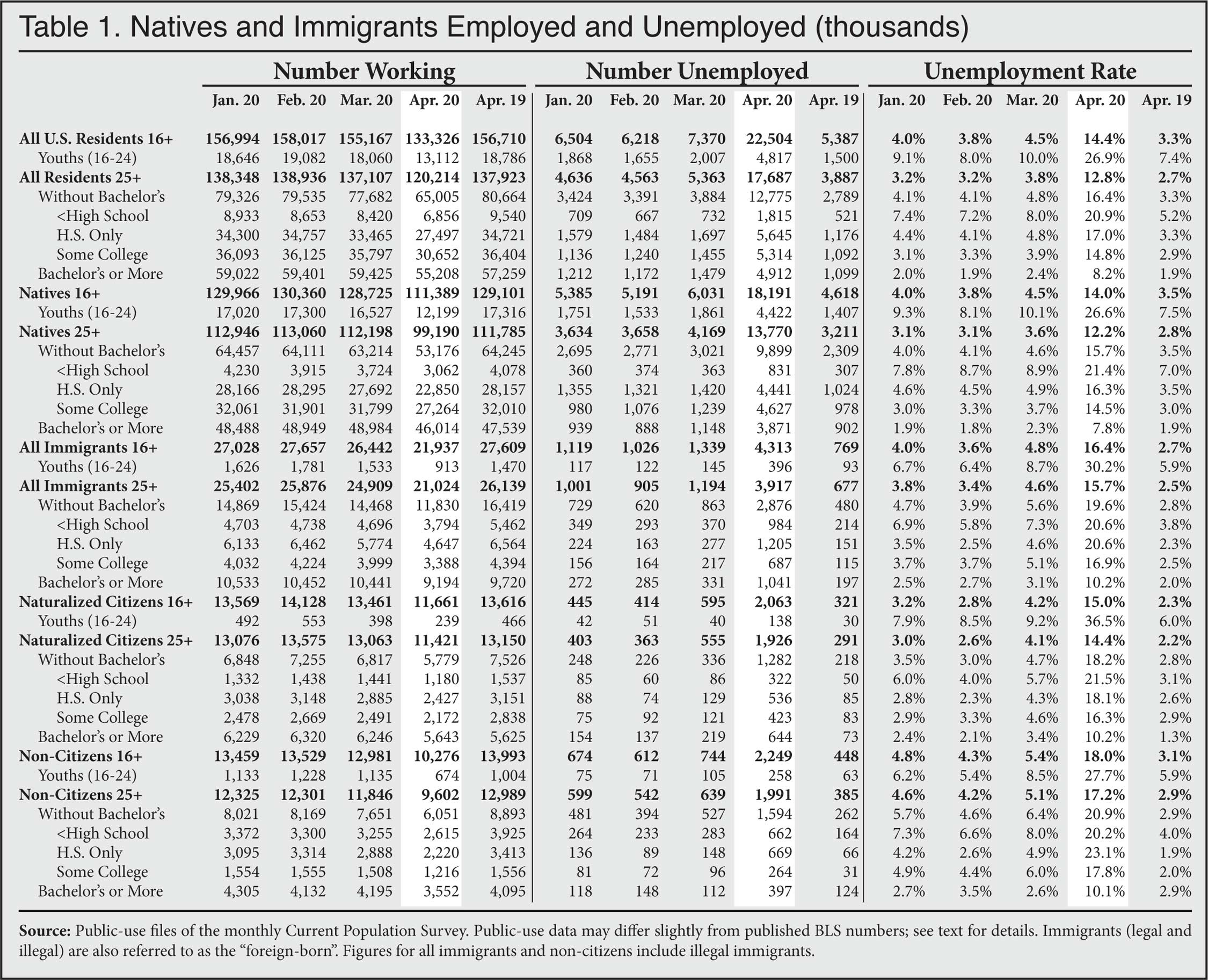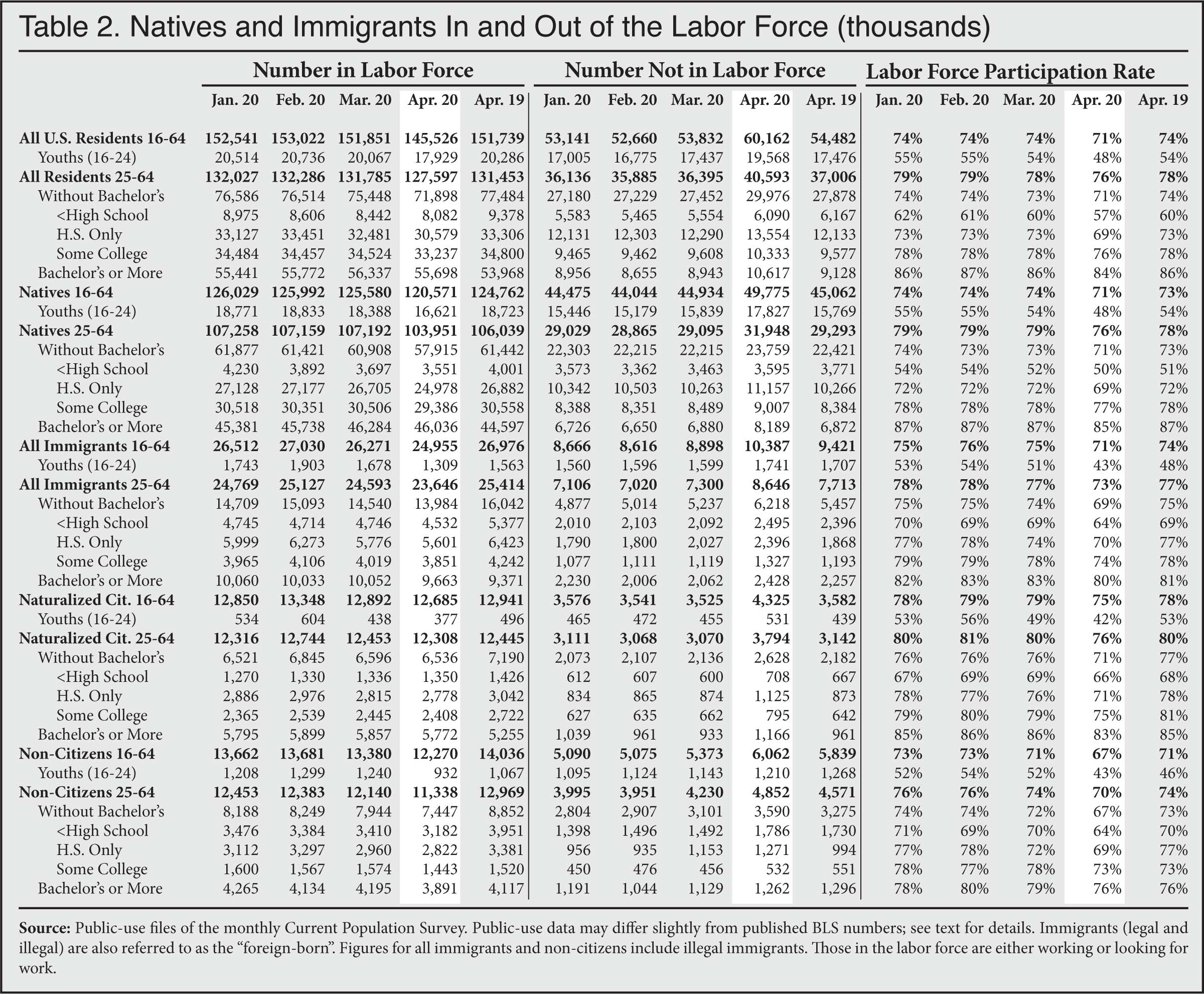Download a PDF of this Backgrounder.
Steven A. Camarota is the director of research and Karen Zeigler is a demographer at the Center. Jason Richwine, PhD, is a public policy analyst based in Washington, D.C., and a contributing writer at National Review.
An analysis by the Center for Immigration Studies of data released last Friday by the Bureau of Labor Statistics shows that both native-born Americans and immigrants (legal and illegal) suffered a massive increase in unemployment in April. With 18.2 million natives and 4.3 million immigrants unemployed, and millions more having given up even looking for work, it is now especially difficult to justify the continued entry of new immigrants on the grounds of any "labor shortage".
While workers of every education level have experienced significant job losses, the situation for workers without a college education is especially bleak. Many jobs traditionally performed by the less-educated have very high unemployment rates, such as landscapers and trimmers (17.5 percent), food preparers and servers (41.8 percent), and butchers and other food production workers (9.1 percent). Even the combined occupations of medical technologists, technicians, and LPNs (8.3 percent) now have a high rate of unemployment by historical standards. Figures and tables are below. An Excel file of the tables can be downloaded here.
Overall findings:
- The unemployment rate for native-born Americans jumped to 14 percent in April 2020, up from 3.8 percent in February before Covid-19 hit. Among immigrants, the rate was 16.4 percent in April, up from 3.6 percent in February. (Figure 1, Table 1)
- There were 18.2 million unemployed natives and 4.3 million unemployed immigrants in April, a 250 percent increase for the native-born and 320 percent increase for immigrants since February. (Figure 2, Table 1)
- In addition to the unemployed, there were 49.8 million working-age (16-64) native-born and 10.4 million working-age immigrants entirely out of the labor force — neither working nor looking for work. This represents an increase of 5.7 million for the native-born and a 1.8 million increase for immigrants since February. (Table 2)
- We estimate the unemployment rate for illegal immigrants in April of 2020 was roughly 19.3 percent, compared to roughly 15.6 percent for legal immigrants and 14 percent for the native-born (Table 4). Estimates by legal status are approximations only.
Among the less-educated:
- The unemployment rate for the native-born (ages 25-plus) without a bachelor's degree was 15.7 percent in April, compared to 7.8 percent for those with at least a bachelor's. Among immigrants (ages 25-plus), 19.6 percent without a bachelor's degree were unemployed compared to 10.2 percent with a bachelor's. (Table 1)
- The unemployment rate for natives in many jobs typically performed by the less-educated is now high. (Table 3)
- 42.0 percent for food preparers and servers
- 21.5 percent for janitors
- 19.1 percent for landscapers, trimmers, and groundskeepers
- 24.0 percent for construction laborers
- 8.7 percent for medical technologists, technicians, and licensed practical nurses
- 7.0 percent for health care aides and nursing assistants
- 8.9 percent for butchers and food processing workers
- The Covid-19 shutdown has exacerbated the long-term decline in the labor force participation rate (share working or looking for work) of the less-educated. In April 2020, only 64 percent of working-age (16-64) natives without a bachelor's degree were in the labor force, down from 71 percent in 2007 and 74 percent in 2000. (Figure 5)
Data and Methods
This report uses the Current Population Survey (CPS) to examine the employment situation in the United States as of April 2020, with particular attention paid to differences between immigrants and natives. Based on a monthly survey of 60,000 households, the CPS is the nation's primary source for the unemployment rate and other labor force statistics. The sample is weighted to reflect the actual size and demographic makeup of the civilian non-institutionalized population. The raw data used in this analysis comes directly from the Census Bureau, which collects the data for the Bureau of Labor Statistics.1
Key Concepts and Terms. The labor force includes all workers, plus non-workers who have actively looked for work in the four weeks prior to the survey. The standard unemployment rate, referred to by the BLS as the U-3 rate, is calculated by dividing the number actively looking for work by the number in the labor force. The labor force participation rate is simply the share of people in the labor force.
Definition of Immigrant. The foreign-born in the CPS are all persons who were not U.S. citizens at birth. They include naturalized citizens, permanent residents (green card holders), temporary visitors, guestworkers, and illegal aliens. We use the term "immigrant" to encompass all of these foreign-born individuals. In Tables 1 and 2 we report figures separately for non-citizens and naturalized citizens. Table 4 reports figures for legal immigrants and illegal immigrants separately.
Identifying Illegal Immigrants. Prior research indicates that most illegal immigrants are included in Census data. To determine which respondents are most likely to be illegal aliens, CIS first excludes immigrant respondents who are almost certainly not illegal aliens — for example, spouses of native-born citizens; veterans; people who have government jobs; Cubans (because of special rules for that country); immigrants who arrived before 1980 (because the 1986 amnesty should have already covered them); people in certain occupations requiring licensing, screening, or a government background check (e.g., doctors, pharmacists, and law enforcement); and people likely to be on student visas.
The remaining candidates are weighted to replicate known characteristics of the illegal population (population size, age, gender, region or country of origin, state of residence, and length of residence in the United States). CIS has previously used the Department of Homeland Security (DHS) as the source of those known characteristics; however, DHS data were last published in 2015. For more recent data, we turn to 2018 estimates from the Center for Migration Studies (CMS), including their estimates of educational attainment.2 The resulting illegal population, which consists of a weighted set of CPS respondents, is designed to match CMS on the characteristics listed above. However, we do not adjust the number of illegal immigrants for undercount in the CPS.3 Estimates for legal immigrants are calculated simply by subtracting estimated counts of illegal immigrants from the total immigrant population.
All of our findings that separate immigrants by legal status should be considered rough approximations only. Because we do not have information about the illegal immigrant population in 2020, we are forced to take the known characteristics of illegal aliens from 2018 and apply them to the new labor market data in 2020. The primary weakness of this approach is that it assumes the illegal immigrant population still has the same demographic profile (population size, age, gender, etc.) as it did in 2018.
Matching Published BLS Tables. In this report, all statistics covering the entire population, such as the headline unemployment rate, match those published by the BLS. However, the counts and percentages for sub-populations will in some cases be slightly different. The reason is that the Census Bureau adds "perturbations" to the public-use microdata to protect respondent confidentiality. Fortunately, the Census Bureau states that any differences between published figures and those calculated from the public-use data will be so small that they "fall well within the sampling variability associated with CPS estimates".4 In other words, there should be no meaningful difference between statistics calculated from the pubic-use data and those published by the BLS.
Finally, the figures in this report are not seasonally adjusted. Unadjusted figures are conceptually simpler and easier for other researchers to replicate.5 Also, the limited number of statistics on the foreign-born published in the BLS monthly "Employment Situation" reports are also not seasonally adjusted.
 |
 |
 |
 |
 |
 |
 |
 |
 |
 |
 |
 |
 |
End Notes
1 "Basic Monthly CPS", U.S. Census Bureau, undated.
2 "State-Level Unauthorized Population and Eligible-to-Naturalize Estimates", Center for Migration Studies, undated.
3 In 2018, CMS estimated a total illegal immigrant population of 10.6 million, which includes an undercount adjustment for those missed in Census Bureau data. Our analysis of the CPS totals to 9.8 million illegal immigrants, reflecting a 7.5 percent undercount.
4 "Monthly Current Population Survey Public Use Microdata Files", U.S. Census Bureau, undated.
5 "Table A-7. Employment status of the civilian population by nativity and sex, not seasonally adjusted", U.S. Bureau of Labor Statistics, May 11, 2020.
